兰州大学研究团队在人类活动对区域和全球泥炭地温室气体排放的影响方面取得系列进展
作者: 发布日期:2022-11-14 浏览:
泥炭地是在长期淹水厌氧环境下有机质分解受抑制而导致泥炭层逐渐积累而发育形成的一类湿地生态系统,是地球上最具价值的生态系统类型之一,其在生物多样性保护、水净化和水循环调控、固碳和减缓气候变化等方面发挥着至关重要的作用。泥炭地仅占全球陆地表面积的~2.84%(约4百万平方公里),却是全球陆地生态系统中至关重要的土壤碳库,其土壤碳储量达5000–7000亿吨碳,占全球陆地土壤碳储量(15000–24000亿吨碳)的21–47%,接近于全球大气总碳库(8600亿吨碳)和森林生态系统总碳库(7910–9270 亿吨碳)。因此,泥炭地被认为是长久且重要的陆地碳汇,在全球实现基于自然的“碳中和”解决方案和气候行动联合国可持续发展目标中发挥着重要作用。
然而,过去百年来全球泥炭地受到了人为排水活动和气候变干的广泛影响,大约50%的欧洲泥炭地受到了人为排水活动的剧烈影响,50–75%的东南亚(亚)热带泥炭地经历了人为排水,43.5%的若尔盖高原高寒泥炭地(是我国乃至全世界最广袤的高原泥炭沼泽复合体之一,是我国最大的高原泥炭沼泽分布区)受到了人为排水活动的影响。据统计,全球大约11–13%的泥炭地受到了人为排水活动的干扰。泥炭地排水后主要用于农作物种植、家畜放牧、牧草生产、林业经营或泥炭开采。排水活动引起泥炭地水位剧烈下降,导致厌氧环境下上万年才积累生成的泥炭土直接暴露在大气中而被快速氧化分解,释放出大量的温室气体如二氧化碳(CO2)和氧化亚氮(N2O),造成全球变暖,还引发泥炭地的大规模塌陷,显著改变地表形态,破坏土壤结构,为其生态恢复带来极大的难度。然而直到目前,关于人为排水后泥炭地土壤碳的大量释放(即土壤呼吸)来源于泥炭土壤有机碳氧化分解(即土壤异养呼吸)还是泥炭地植物地下根系呼吸(即土壤自养呼吸)抑或二者都很重要,还缺乏明确的认识。更缺乏对人为排水活动下泥炭地水位下降、土壤碳排放和地表塌陷速率间的稳健定量关系的构建,导致人为排水活动引起的全球泥炭地土壤碳排放量(土壤呼吸及其组分土壤异养呼吸和自养呼吸)和地表塌陷速率缺乏精细定量,严重制约了人类对排水泥炭地在全球碳排放中重要性的了解。
针对以上关键科学问题,兰州大学大气科学学院地气相互作用与全球变化团队马磊青年研究员和左洪超教授使用荟萃分析(Meta-analysis)和自举重采样(Bootstrap-resampling)以及全球尺度扩展(Global upscaling)等方法,首次明确了人为排水导致的水位下降主要通过促进土壤异养呼吸而非自养呼吸而促进土壤呼吸(图1),从而引起泥炭地地表的大规模塌陷,且这种级联效应广泛存在于全球不同气候带不同土地利用类型之中(人为排水后的不同土地利用方式如农田、草地)(图2)。在此基础上,研究团队构建了基于地表塌陷速率计算全球不同气候带、泥炭地不同土地利用类型的年土壤异养呼吸排放量的公式,精细估算了由人为排水活动引起的土壤异养呼吸年排放量空间分布特征和全球总排放量(图3和表1),结合土壤异养呼吸占土壤呼吸的比例(图4),估算了人为排水活动引起的全球泥炭地土壤呼吸年排放总量为23.6(14.7–37.6)亿吨 CO2(表1)。结果表明,受人为排水活动影响的全球泥炭地以仅占全球陆表的~0.3%的面积,却贡献了全球土地利用变化年CO2总排放量(168.7亿吨CO2)的~14%(8.7–22%),贡献了全球化石燃料和土地利用变化年CO2总排放量(513.3亿吨CO2)的~4.6%(3.0–7.3%)。这些研究结果突显了保护自然泥炭地和恢复退化泥炭地对减缓气候变化的重要作用。
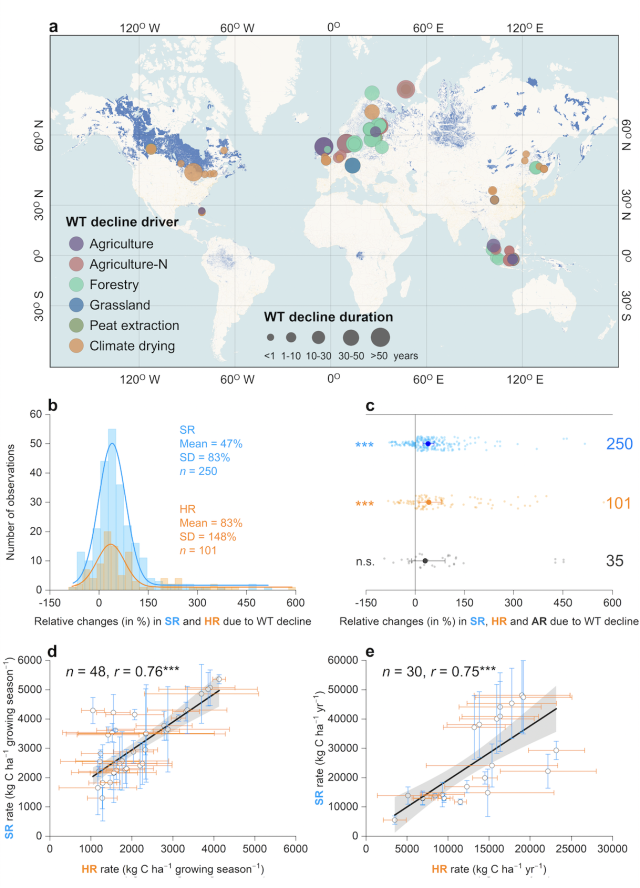
图1 Relative changes in soil respiration (SR) and its components, heterotrophic respiration (HR) and autotrophic respiration (AR), due to water table (WT) decline in global pristine peatlands. a Distribution of the in situ observations. b Frequency distributions of the relative changes in SR and HR due to WT decline (AR was not shown due to the scarcity of data points (n = 35)). c Relative changes in SR, HR and AR due to WT decline. d Pearson correlation of the growing season HR and SR rates in pristine and drained boreal peatlands. e Pearson correlation of the annual HR and SR rates in pristine and drained tropical peatlands. No data were observed in pristine and drained temperate peatlands. Each data point for WT decline impacts on in situ SR and its components was classified on the basis of the driver of WT decline and duration of WT decline in (a). The grey–blue regions in (a) indicate the global distributions of peatlands derived from PEATMAT5. The larger solid circles and horizontal bars in (c) denote the weighted means of relative changes and their 95% confidence intervals. The smaller circles and numbers in (c) indicate individual relative changes due to WT decline and the number of data points, respectively. The open circles and bars in (d, e) show the means and standard deviations for individual data points. The asterisks *, **, *** indicate significance at the levels of p < 0.05, 0.01 and 0.001, respectively, and n.s. indicates no significance (for details, see Meta-analysis in Methods).
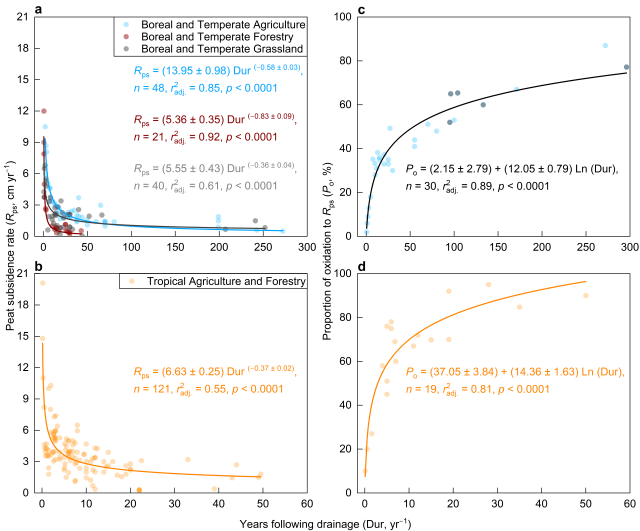
图2 Drainage duration controls peat subsidence rate (Rps) and the proportion of peat oxidation to Rps (Po). a, b Relationships of Rps with drainage duration (i.e., years since drainage) for drained peatlands across different climate zones and land uses. c, d Proportion of subsidence attributed to peat oxidation (Po) with drainage duration for drained peatlands across different climate zones and land uses. The fitted regression curves and their 95% confidence intervals are shown. The same Po was used for drained boreal and temperate peatlands under different land uses due to a lack of sufficient observations. Similarly, the same Po was used for drained tropical peatlands under different land uses.
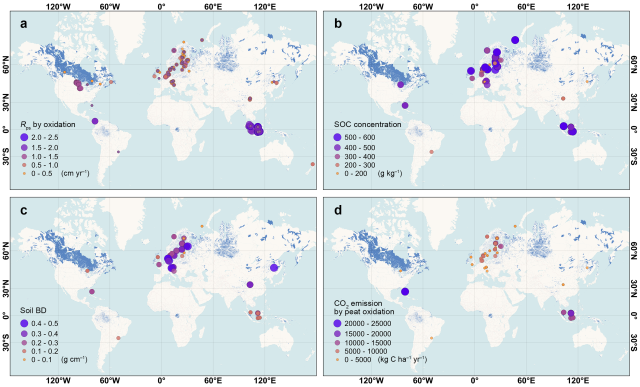
图3 Peat subsidence rate (Rps) (cm yr–1) due to oxidation and associated soil heterotrophic CO2 emissions. Spatial variations in the (a) estimated Rps due to oxidation of drained peatlands, (b) soil organic carbon (SOC) concentration (g kg–1) of pristine peatlands, (c) soil bulk density (BD, g cm–3) of pristine peatlands, and (d) estimated soil heterotrophic CO2 emissions due to peat oxidation (kg C ha–1 yr–1) among global drained peatlands. For the calculation processes of Rps and HR, see the Methods. The grey‒blue regions indicate the global distributions of peatlands derived from PEATMAT5.

图4 Contributions of soil heterotrophic respiration (HR) to soil respiration (SR). a Contributions for pristine and drained peatlands. b Contributions for drained boreal and tropical peatlands. The same lowercase letter within the plot indicates no significances of median or mean between pristine and drained peatlands or drained boreal and tropical peatlands at the level of p < 0.05 using Mann-Whitney U-Test. The notes in (a) are also applied to (b).

以上研究成果以“A globally robust relationship between water table decline, subsidence rate and carbon release from peatlands”为题于10月29日发表在Nature新刊Communications Earth & Environment(图5),并被编辑部遴选为封面论文。文章在线发表后,受Nature Portfolio Communities高级经理Dr. Eve Satkevic的邀请,研究团队在Nature Portfolio Earth and Environment Community以“Critical importance of conserving (near)pristine peatlands and restoring drained peatlands for climate change mitigation”为标题分享了研究工作背后的故事,并强调了保护全球自然泥炭地和恢复退化泥炭地对减缓气候变化极为重要(图6)。
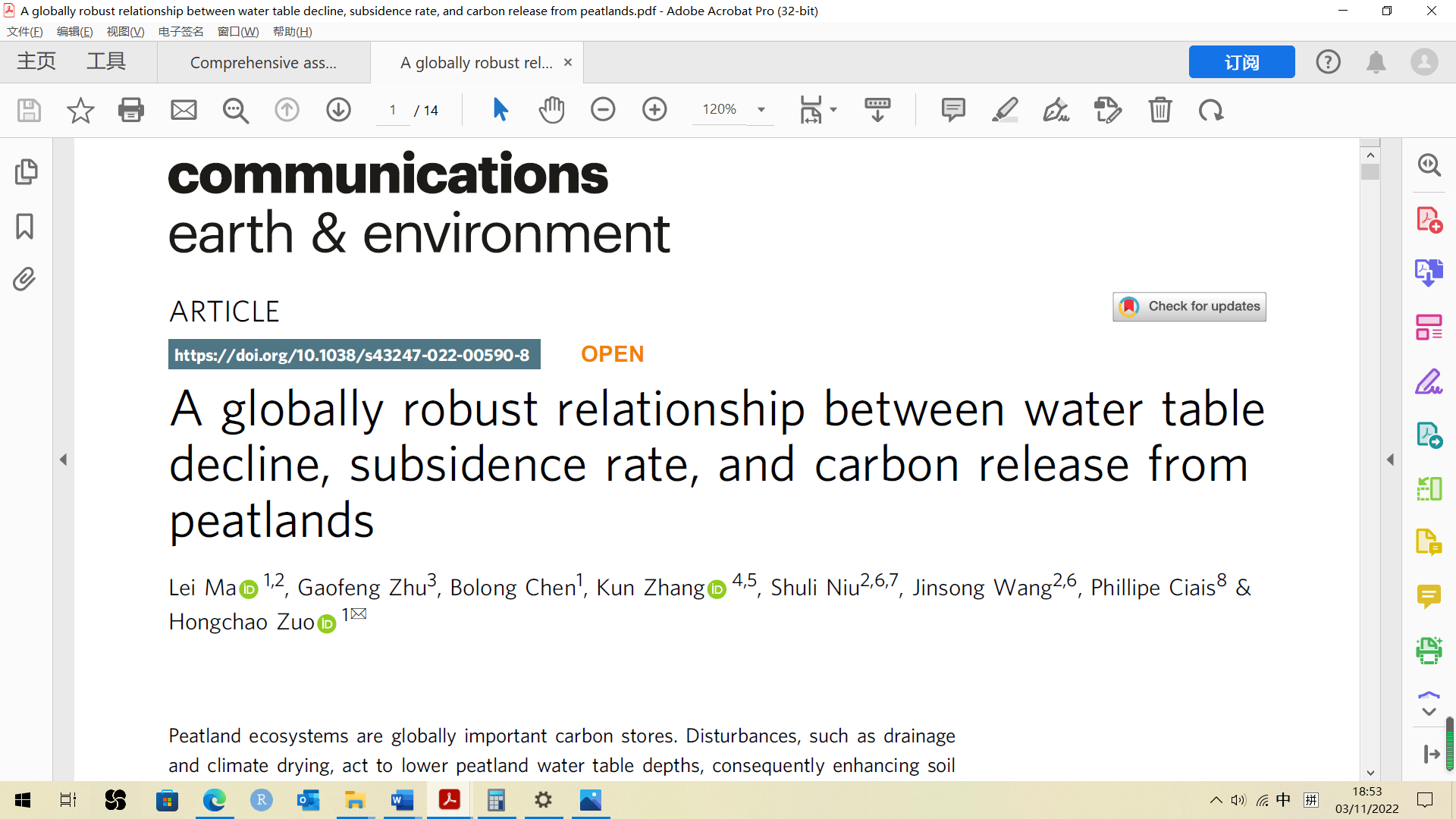
图5 Published paper in Communications Earth & Environment

图6 Post story behind the paper sharedin Nature Portfolio Earth and Environment Community.
泥炭地人为排水及伴随的土地利用变化如放牧可强烈影响泥炭地–大气间CO2净交换。基于此,研究团队就2021年发表在PNAS的《Plant uptake of CO2outpaces losses from permafrost and plant respiration on the Tibetan Plateau》一文进行了评述。研究团队肯定了青藏高原高寒生态系统整体是碳汇的观点,同时指出了该研究未考虑多样的人类活动如高寒泥炭地排水和高寒草地放牧对生态系统碳平衡的影响,而忽略这些多样的人类活动可能是导致作者们估算的青藏高原碳汇是前人估算量的4倍的重要原因之一,因为青藏高原上大量的高寒泥炭地被人为排水并用于放牧以及高寒草地(青藏高原上分布最广的高寒生态系统)被主要用作放牧草场(图7)。基于此,研究团队重新分析了作者们提交的数据,并且补充了相应观测样地的人类活动等信息。研究团队发现自然高寒泥炭地(平均值 ± 95%置信区间:1784 ± 454 kg C ha–1 yr–1)的年净生态系统生产力(NEP)显著(P< 0.001)高于排水泥炭地(1784 ± 454 kg C ha–1 yr–1)(图8A),而天然草地、灌丛和放牧草地、灌木丛间的年NEP却无显著差异(图8B)。此外,家畜采食会大量地移除放牧泥炭地和草地的净初级生产力(Net Primary Productivity),而通过牲畜排泄物返回的碳量却较少;因此,可以推断,多种人类活动将进一步降低高寒泥炭地和高寒草地的净碳汇能力。忽略这些重要的碳损失过程可能共同解释了为什么作者们发现与之前的模型预测或土壤重采样测量相比,青藏高原碳净固定量大约高出3倍。从这个角度来看,在未来的研究中,在评估青藏高原高寒生态系统净碳平衡时,应考虑多种人类活动的影响。包含人类活动信息也有助于为减少热点排放源(如排水高寒泥炭地)的大量碳排放找到解决方案(图8A)。该评述文章以“Quantifying net carbon fixation by Tibetan alpine ecosystems should consider multiple anthropogenic activities”为题于2月1日以Letter形式发表在PNAS(图9)。
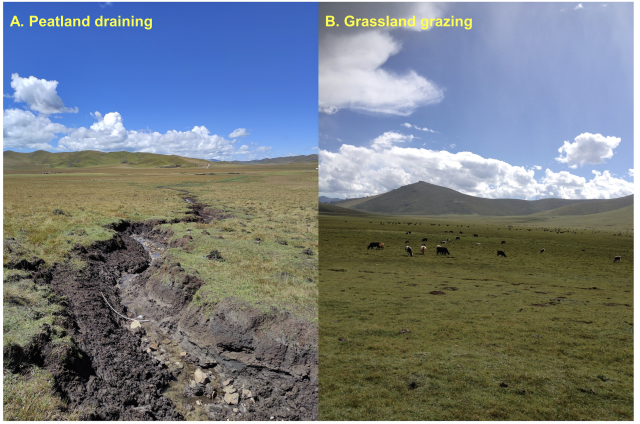
图7 Landscapes of peatland draining (A) and grassland grazing (B) on the Tibetan Plateau (photo by Lei Ma).

图8 Net ecosystem production of alpine ecosystems under different disturbances. The *** and n.s. indicate P< 0.001 and no significance, respectively. The datasets are directly extracted from Wei et al. (2).
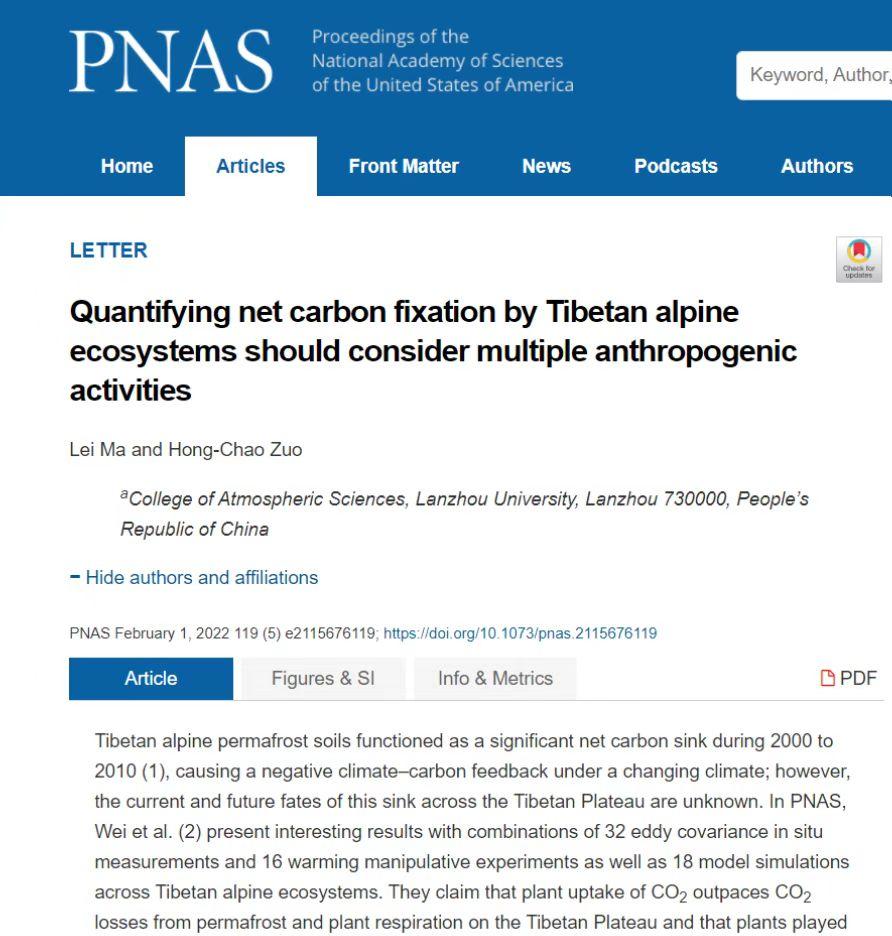
图9 Published Letter in PNAS
此外,泥炭地还是重要的氮库,其氮储量占全球陆地生态系统总储量的~10%。由于人类排水活动导致表层泥炭土直接暴露于空气中,显著促进了表层泥炭土土壤硝化和(或)反硝化作用,从而引起温室气体N2O的大量产生和排放,因而泥炭地被认为是大气N2O的重要源。但是,目前对泥炭地不同状态(自然 vs. 排水 vs. 恢复)、不同气候带(热带vs. 温带vs. 寒带)、不同营养类型(矿养型Minerotrophic vs. 雨养型Ombrotrophic)等条件下的N2O排放量级、空间分布特征和驱动机制仍缺乏详细了解,严重制约了区域至全球尺度上泥炭地N2O总排放量的准确估算以及其减排潜力的精细评估。
基于此,研究团队使用综合分析(Synthetic analysis)和自举重采样(Bootstrap-resampling)以及区域尺度扩展(Global upscaling)等方法,利用欧洲泥炭地丰富的全年N2O观测数据(492个全年N2O观测数据样本,其他大洲缺乏观测数据),发现泥炭地年N2O通量呈现巨大的空间变异性,变化范围在–1.08至33.40 kg N2O-N ha-1 yr-1间(图10);这种空间变异性特征受到泥炭地状态、气候条件和营养物质供应类型的共同影响。排水活动显著促进矿养型(Minerotrophic)泥炭地N2O的排放,而不影响雨养型(Ombrotrophic)泥炭地N2O的排放,这种影响在不同气候带均成立。类似的,恢复可以显著降低矿养型排水泥炭地N2O的排放,而不能有效降低雨养型排水泥炭地N2O的排放(图10)。这些结果表明泥炭地N2O的排放受到水位和土壤氮素有效性的共同驱动(图11)。研究还发现欧洲泥炭地是巨大的N2O排放源(2020年基准年排放量为90.42 (64.49~122.57) Gg N2O-N yr-1,占到欧洲农业N2O排放源的17.38%(15.23–20.15%)),其中排水泥炭地占到所有泥炭地N2O排放量的87.27%,而排水后用作林业用地又占到全部排水泥炭地N2O排放量的46.67%,草地则占29.82%,农田占22.74%,泥炭开采最少,仅占0.77%(图12)。这些结果强调了欧洲排水泥炭地N2O减排的重要性。因此,本研究开发了动态考虑排水泥炭地恢复过程中水位和土壤碳氮比(C/N)变化的经验模型(图13),设置了8种泥炭地恢复情景,评估了N2O减排潜力(图14)。结果表明排水泥炭地越早恢复,越有利于减少N2O的排放量。在不损害粮食安全的前提下,恢复全部的林业和泥炭开采的排水泥炭地的水位至地表,而恢复农业和草地生产的排水泥炭地水位至地下15 cm处(减少对禾本科植物根系生长的抑制效应),可最大幅度的减少欧洲泥炭地N2O排放,同时不造成农作物和牧草减产。
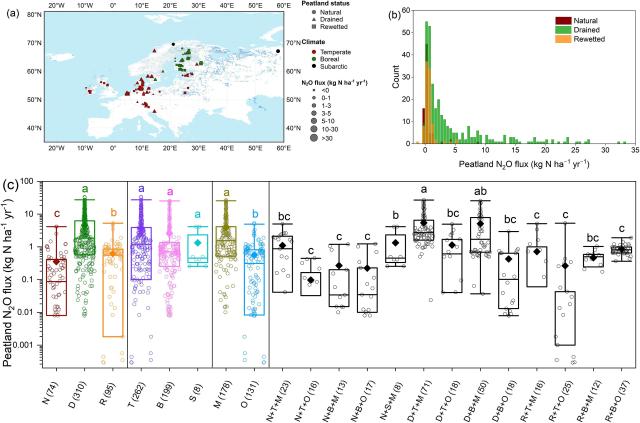
图10 (a) Distribution of synthesized annual flux datapoints across European peatlands. (b) Frequency distributions of annual nitrous oxide (N2O, kg N2O-N ha-1 yr-1) fluxes for natural, drained and rewetted peatlands. (c) Boxplot for multiple comparisons of annual mean N2O fluxes from European peatlands under different peatland statuses (N = natural wetland, D = drained wetland, and R = rewetted wetland), climatic regimes (T = temperate, B = boreal, and S = subarctic) and nutrient supply types (M = minerotrophic and O = ombrotrophic), as well as three simultaneously considered factors; the numbers in parentheses indicate the datapoints within each subgroup. The boxplot shows the median (central thick lines), mean (rhomboidal points), 25% and 75% quartiles, and 1% and 99% ranges (i.e., the upper and lower whiskers) around the median. Datapoints above (below) the upper (lower) whisker indicate outliers. The same lowercase letter indicates a lack of mutually significant differences at the 95% confidence level. The distribution of European peatlands was derived from PEATMAP (http://peatdatahub.net/).
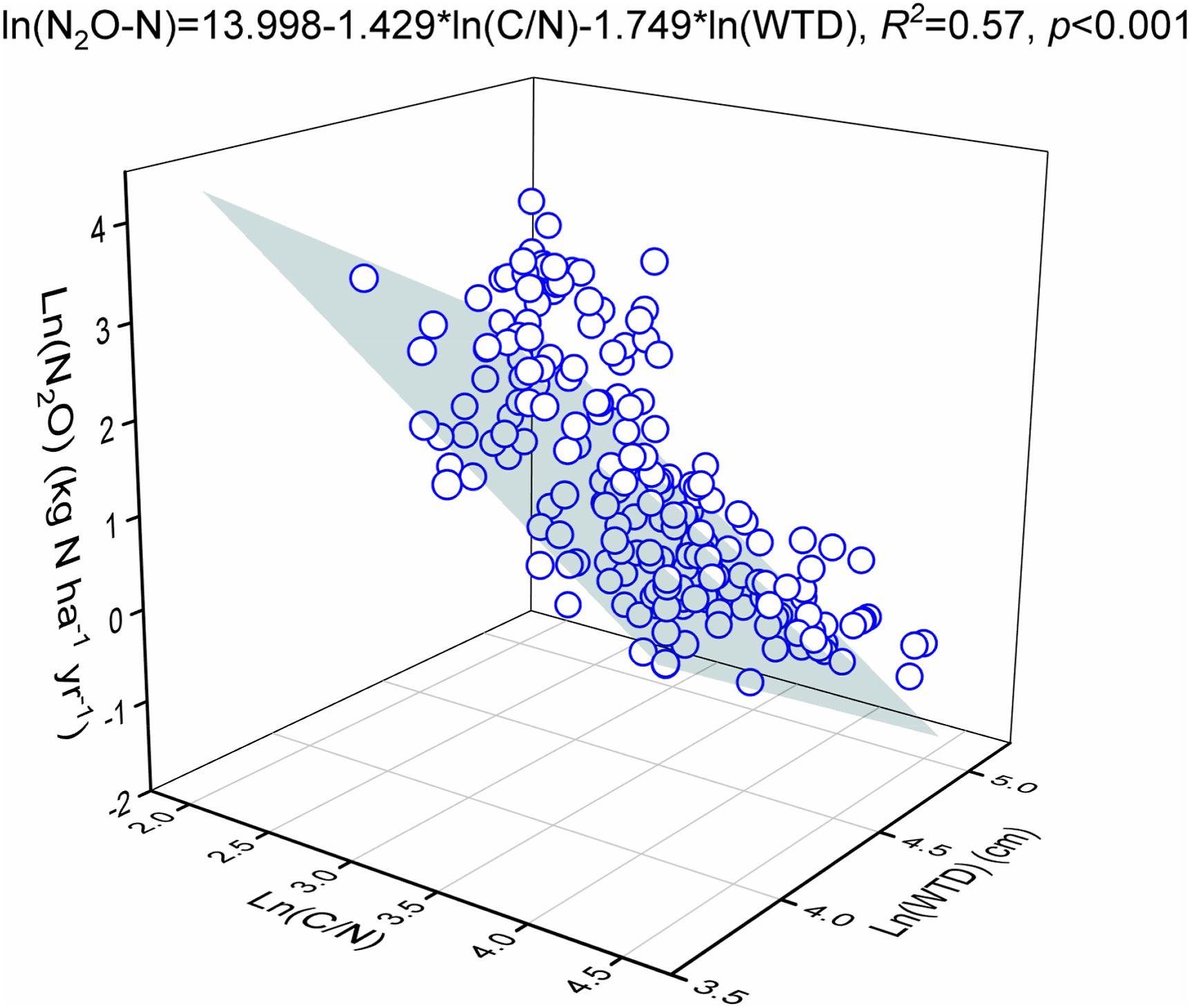
图11 Binary relationship between annual mean N2Ofluxes and annual mean water table depth (WTD) and soil (0–30 cm) carbon to nitrogen ratio (C/N) across different peatlands in Europe. The annual N2O fluxes, WTD and soil C/N ratios were log-transformed. For the data analysis method, see the statistical analysis section in the body text.
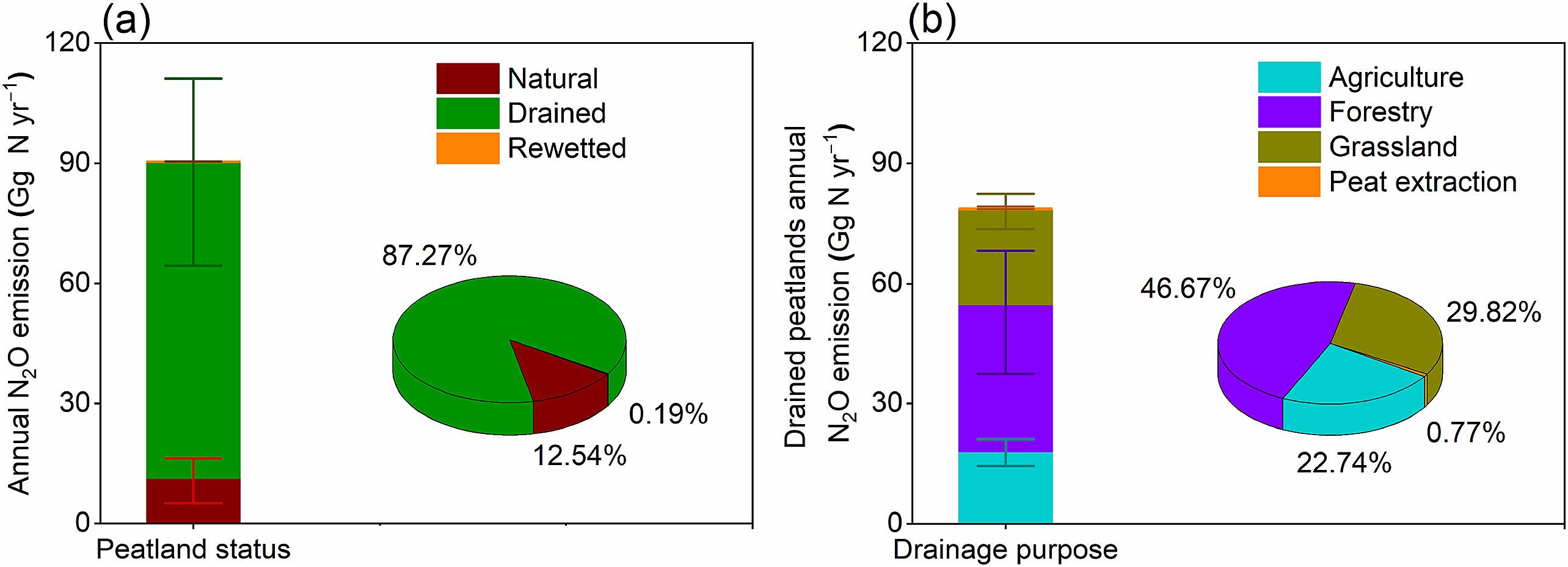
图12 Total annual N2O emissions from European peatlands (a) and drained peatlands (b) in 2020 (baseline emissions). The vertical error bars indicate the 95% confidence intervals which were obtained on the basis of a bootstrapping method. For the emission estimation method details, see the statistical analysis section in the body text.
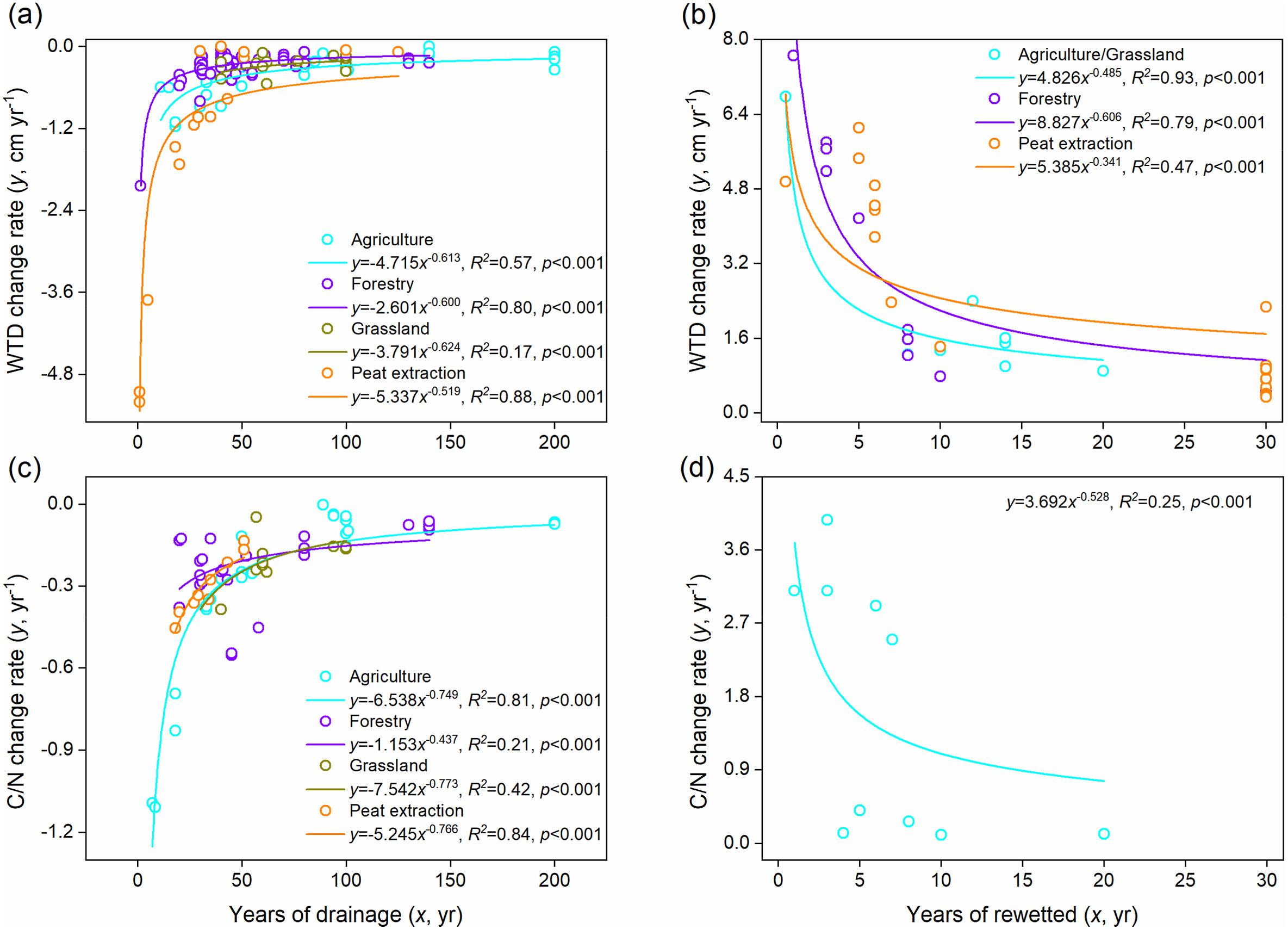
图13 Regression analysis of the annual change rate of peatland water table depth (WTD) or soil (0–30 cm) carbon to nitrogen ratios (C/N) versus years since drainage (a and c), and rewetting (b and d). For subfigure d, we were unable to fit regression curves for different land-use histories before rewetting due to the lack of enough observations.
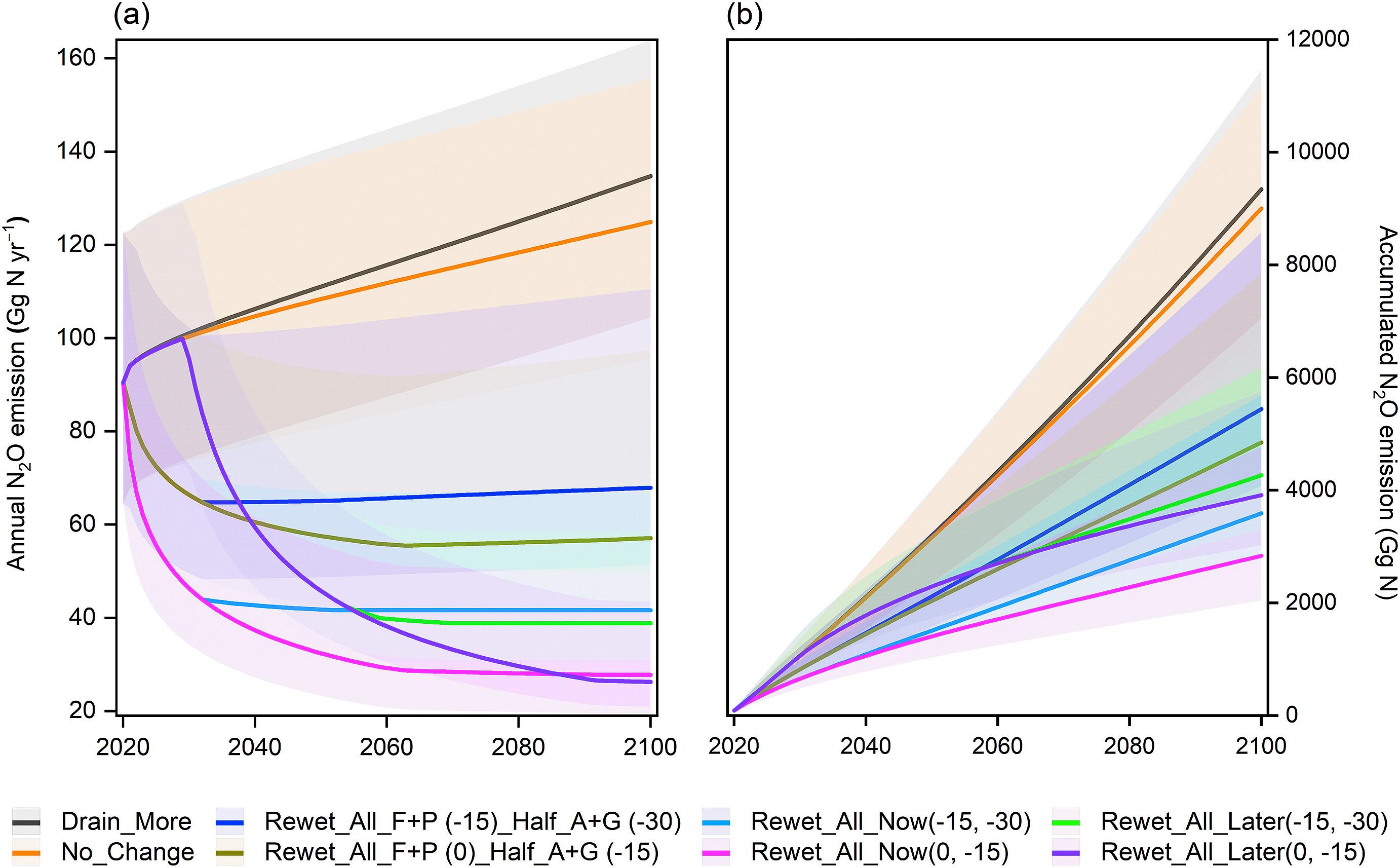
图 14 Estimated 2020–2100 annual mean (a) and cumulative (b) N2O emissions across European peatlands under different scenarios. The shaded areas of the annual and cumulative mean N2O emissions represent the 95% confidence intervals (CIs), which were obtained on the basis of a bootstrapping method. For details of the estimation method, see the statistical analysis section in the body text.
以上研究成果以“Comprehensive assessment of nitrous oxide emissions and mitigation potentials across European peatlands”为题于5月15日发表在生态学与环境科学领域重要期刊Environmental Pollution(图15)。
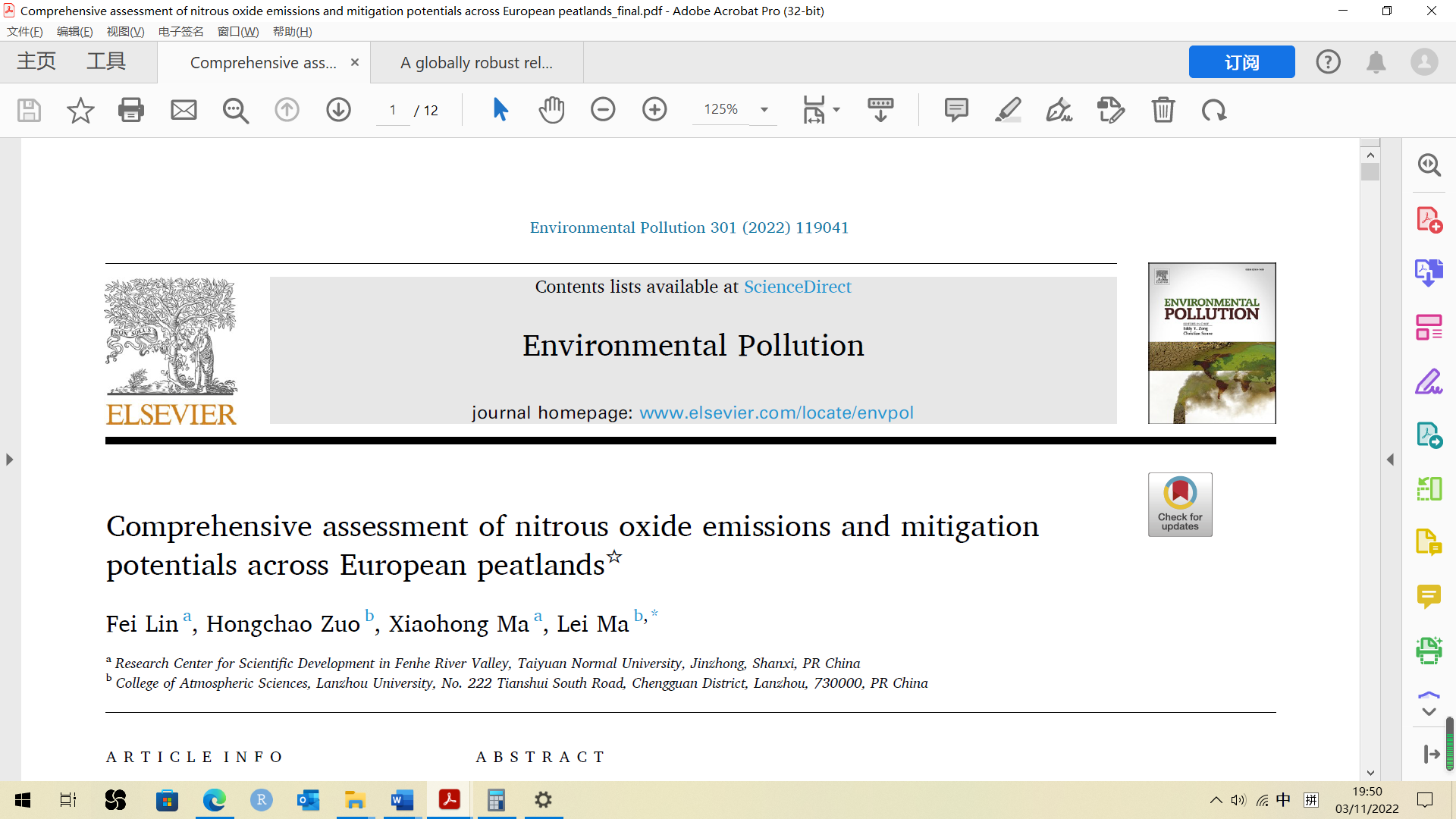
图15 Published paperin Environmental Pollution
这些研究工作得到了第二次青藏高原综合科学考察研究计划(STEP)(2019QZK0103)、兰州大学“双一流”建设经费(561120206)、中德博士后奖学金项目(CSC–DAAD,57460082)、山西省自然科学基金–青年科学基金(201901D211420)和中国科学院内陆河流域生态水文重点实验室课题(KLEIRB-ZS-20-05)的共同资助。兰州大学大气科学学院青年研究员马磊和教授左洪超领衔了这些研究工作,合作者包括兰州大学资源与环境学院朱高峰教授,兰州大学大气科学学院陈伯龙高级工程师,香港大学数学系、生物科学学院博士后张琨、中国科学院地理科学与资源研究所牛书丽研究员和汪金松副研究员、法国国家气候与环境科学实验室Phillipe Ciais教授和太原师范学院林菲博士和马小红博士。
相关论文信息(*通讯作者):
(1)Lei Ma, Gaofeng Zhu, Bolong Chen, Kun Zhang, Shuli Niu, Jinsong Wang, Phillipe Ciais, Hongchao Zuo*. 2022. A globally robust relationship between water table decline, subsidence rate, and carbon release from peatlands. Communications Earth & Environment. 3, 254. https://doi.org/10.1038/s43247-022-00590-8
(2)Lei Ma* & Hongchao Zuo. 2022. Quantifying net carbon fixation by Tibetan alpine ecosystems should consider multiple anthropogenic activities. Proceedings of the National Academy of Sciences of the United States of America, 119, 1–2.https://doi.org/10.1073/pnas.2115676119
(3)Fei Lin, Hongchao Zuo, Xiaohong Ma, Lei Ma*. 2022. Comprehensive assessment of nitrous oxide emissions and mitigation potentials across European peatlands. Environmental Pollution, 301, 119041.https://doi.org/10.1016/j.envpol.2022.119041
(来源:https://news.lzu.edu.cn/c/202211/95040.html)





